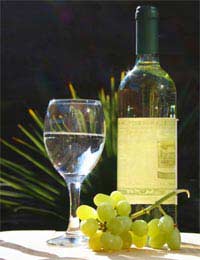White Wine Making

White wine making is an art that has been developed over time. A wide range of white wine can be made encompassing all from the most delicately flavoured to the robust full-bodied.
But before we get onto the stages of white wine making, let’s go back to basics. Since the pulp of almost all grapes is white – or to be more accurate, pale green, yellow or pinky-white - white wine can be made from both white and red grapes. However it is more often made from white grapes to avoid the necessity to remove the skins before fermentation. If the skins are allowed to stay in the process too long, they will affect both the colour and the tannin level of the final product.
Harvesting the grapes
As harvest time approaches the grapes on the vine are monitored on a daily basis until the winemaker decides that they’re ready for harvesting. This decision will depend on a number of factors including sugar content, flavour and condition of the grapes.The grapes are harvested carefully either by hand or by machine. At this stage they have to be treated gently to avoid unwanted damage. The harvested grapes are then transported as rapidly as possible to the winery.
The First Crush
On arriving at the winery the grapes are crushed lightly and the stems and some of the pips are removed. Once crushed the grapes go into the press where the juice is extracted and gathered in containers. It’s allowed to stand for up to 12 hours to allow any skins, pips or other unwanted impurities to come to the surface and be removed before fermentation begins.Fermentation
Now yeast is added and the fermentation process, which involves sugar being converted into alcohol, is begun. It continues for 1 - 4 weeks and is checked daily.One of the most important factors during the fermentation process is the temperature of the tank: a temperature of about 15 – 18oC is necessary to preserve the subtle characteristics of the fruit. The comparatively recent invention of temperature-controlled stainless steel fermentation tanks has made the production of white wine possible even in hot countries that have no tradition of white wine making.
In spite of the added difficulty of keeping a steady cool temperature, some winemakers prefer to use old oak barrels for fermentation as the wine thus made will be fuller-bodied and will have taken on some of the characteristics of the oak.
It’s very important at all stages for the grapes to have as little contact with oxygen as possible. Oxidation can cause discolouring or spoiling of the finished wine.
Finally
When the winemaker determines that fermentation is finished, the wine is racked. This allows the separation of the wine from its yeast debris. Some full-bodied wines may be left to rest on the yeast for a little while longer and the yeast may even be stirred up to increase creaminess and complexity of flavour.Similarly a full-bodied white wine may have malo-lactic bacteria added to break down the sharp malic acid into a gentler lactic acid, giving a softer texture. All these decisions will be the responsibility of the winemaker, who needs to call on all of his or her acquired wisdom and instinct to create a good wine.
Before the wine is bottled it will have fining agents added. These act like magnets and draw any remaining impurities to them as they sink to the bottom so the wine can be filtered off to create a wonderfully clear liquid ready for bottling.
Mature White Wine
Some white wine – chardonnay is a favourite - will be allowed to mature in oak barrels. This lets the wine take on an added buttery flavour from the oak.On the whole, white wine will not keep as long as red wine once bottled. Red wine has the benefit of plenty of tannin, which acts as a preservative.
Grape Varieties
One of the factors affecting the taste of the white wine is, of course, the grape from which it is made.- Chardonnay grape gives you a full, soft and fruity wine.
- The sauvignon blanc grape leads to a drier more acidic wine with a distinctive flavour.
- When the Gewurztraminer grape is used, the wine will be spicy and oily on the tongue.


Re: Strawberry Wine
Trying to find Kellercup Strawberry Hock or something like please
Re: Strawberry Wine
I was a big fan of Kellercup Strawberry Hock sparkling wine when in my early 20s! Where can I buy it from in the UK please?
Re: Strawberry Wine
I'm with lynn--I used to drink Kellercup in the 80's and I would love to have some now. PLEASE help us find a supplier here in the U.S. !!
Re: Strawberry Wine
You mention the German Kellercup Strawberry wine in your article. I used to drink this in the late 70's early 80's and it was absolutely delicious.…
Re: Non-Alcoholic Wine
I thank the engineer whom developed such a product, well done, non alcoholic wine is great.